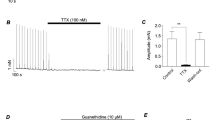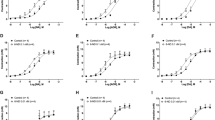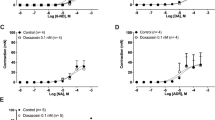Abstract.
This study investigated the effects of changing the extracellular Ca2+ concentration on facilitation of excitatory junction potential (EJP) amplitude during trains of 20 stimuli at 1 Hz at sympathetic neuroeffector junctions in the guinea-pig vas deferens. These effects were compared with those of Ca2+ channel blockers and agents which act at prejunctional receptors to increase or decrease neurotransmitter release. In these experiments, α-adrenoceptor-mediated autoinhibition of neurotransmitter release was blocked by the α-adrenoceptor antagonist, phentolamine (1 µM).
Varying the extracellular Ca2+ concentration (0.75–6 mM) changed the amplitude of EJPs without affecting the maximum level of facilitation during the trains of stimuli. Reductions in Ca2+ concentration (from 2 mM) were associated with a slowing in the rate of development of facilitation. The Ca2+ channel antagonists, Cd2+ (2 µM and 5 µM) and ω-conotoxin GVIA (10 nM), and agents which act at prejunctional receptors to reduce neurotransmitter release, adenosine (100 µM and 1000 µM) and prostaglandin E2 (PGE2; 0.1 nM and 1 nM), produced similar effects to those of lowering the extracellular Ca2+ concentration. Raising the extracellular Ca2+ concentration (from 2 mM) increased the rate of development of facilitation. Angiotensin II (AII; 0.5 µM) produced similar effects to raising extracellular Ca2+. However, isoprenaline (1 µM), while increasing EJP amplitude, reduced the maximum level of facilitation and was without effect on the rate of development of facilitation.
In the guinea-pig vas deferens EJPs are produced by neurally released ATP. Thus, the findings support the idea that adenosine, PGE2 and AII change ATP release by modifying Ca2+ entry into the nerve terminal. However, the effects of isoprenaline may not solely be accounted for by modifications in Ca2+ entry.
Similar content being viewed by others
Author information
Authors and Affiliations
Additional information
Electronic Publication
Rights and permissions
About this article
Cite this article
Hardy, T., Brock, J. Effects of modulating Ca2+ entry and activating prejunctional receptors on facilitation of excitatory junction potentials in the guinea-pig vas deferens in vitro. Naunyn-Schmied Arch Pharmacol 363, 515–525 (2001). https://doi.org/10.1007/s002100000394
Received:
Accepted:
Issue Date:
DOI: https://doi.org/10.1007/s002100000394




